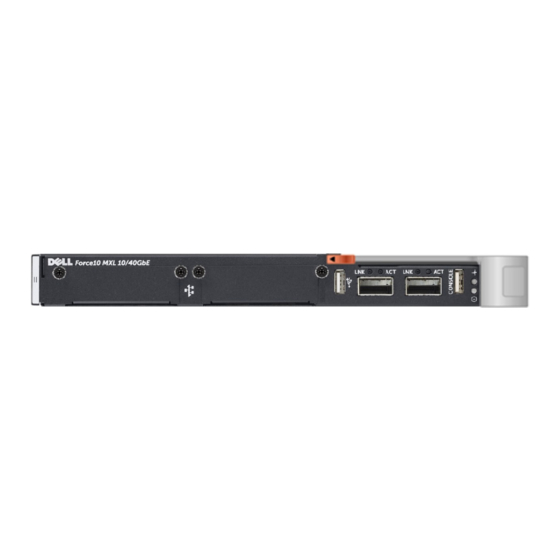Dell Force10 MXL 10 GbE Manual - Page 16
Browse online or download pdf Manual for Switch Dell Force10 MXL 10 GbE. Dell Force10 MXL 10 GbE 27 pages. 10/40gbe blade switches
Also for Dell Force10 MXL 10 GbE: Getting Started Manual (38 pages)

Stacking Dell Force10 MXL 10/40G Switches
In this example, stack-groups 0 and 1 correspond to the base MXL interfaces 33 and 37. Stack-groups 4
and 5 correspond to the two 40G QSFP+ expansion module interfaces inserted in slot 1. Since stacking
MXL switches does not use 10Gig Interfaces, there are no stack-groups associated with the SFP+ or
10GbaseT port that may be installed. Those modules and ports are only used for uplinks on the MXL
switch.
Note: In this example, since an SFP+ expansion module was inserted in slot 0 during boot up, stack-
groups 2 and 3 are not available.
Note: If we had the SFP+ module present in Slot 1, and the QSFP+ module present in Slot 0, then the
stack-groups 4 and 5 would be unavailable, and the stack-groups 2 and 3 would be available,
corresponding to interfaces 0/41 and 0/45.
Note: Activatation of the ports to be used for stacking (using the no shutdown command) isn't
necessary on the ports to be used for stacking.
Configuring priority and stack-group
Using the commands below, configure the Priorities and stack-groups for each of the MXL 10/40GbE
Switches.
Setting the Priority will determine which switch will become the management (Master) switch. The
switch with the highest priority number is elected Master. The default Priority is 0. Priorities for the
stack-unit can be configured using the command 'stack-unit <unit-number> priority <1-14>' from the
configuration mode as follows:
FTOS(conf)#stack-unit 0 priority ?
<1-14>
FTOS(conf)#stack-unit 0 priority 12
Note: It is best practice to assign Priority values to all switches before stacking them in order to
acquire and retain complete control over each units role in the stack.
Stack-groups (below) are easier to think of simply as "stack ports." For example, using the stack-
group 0 command simply turns the lower port (port 33) into a stacking port, stack-group 1 command
turns the next port (port 37) into a stacking port, and so on. See
stacking-group mappings. The stack-group (port) for each stack-unit are configured using the command
'stack-unit <unit-no> stack-group <stack-group-id>' from the configuration mode as follows:
FTOS(conf)#stack-unit 0 stack-group 0
FTOS(conf)#02:26:05: %STKUNIT0-M:CP %IFMGR-6-STACK_PORTS_ADDED: Ports Fo 0/33
have been configured as stacking ports. Please save and reload for config to take effect
Continue to run the stack-unit 0 stack-group <1-5> command to add additional stack ports to the
switch, using the stack-group mapping shown in Figure 3.
Priority Value
Figure 3
for a complete list of
14
